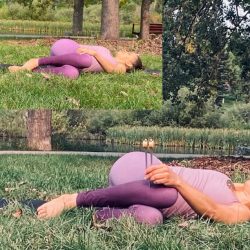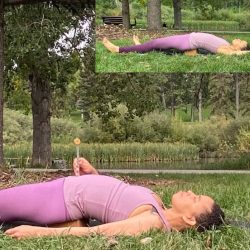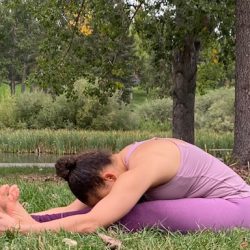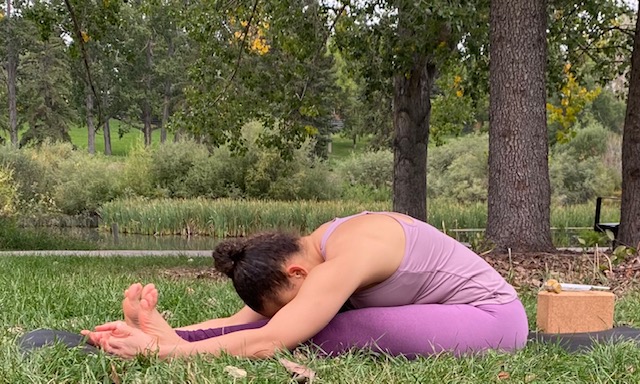Welcome to the world of Vibrational Yin. Vibrational Yin is a form of practice that deeply combines the wisdom of Traditional Chinese Medicine with Yin yoga postures. It is a profound practice that has the ability to affect our physical, mental, and emotional wellbeing. Vibrational yin includes the stimulation of specific acupoints while in yin yoga postures. Acupoints are points along the body’s energy pathways in Traditional Chinese Medicine acupuncturists stimulate to enhance the body’s natural ability to heal. In self-care practices, acupoints are normally stimulated via pressing or tapping on the point. This is known as acupressure. In Vibrational Yin acupoints are more commonly stimulated using tuning forks. Tuning forks used in sound healing resonate at frequencies that promote mental and physical health. The vibrations produced by the tuning forks stimulate the acupoints, moving the body to a state of better health.

The below sequence is designed to improve back health. The yin yoga postures create gentle stresses on the joints and supportive tissues of the spine. The acupoints are used to strengthen the spine, by acting on energy pathways – also known as meridians in Traditional Chinese Medicine- that directly or indirectly affect spinal health. Have fun with this sequence. There are several different types of tuning forks available for body tuning or sound healing. If you are using forks in this practice, ensure the forks are designed specifically for body tuning. Go with your gut feelings. If the vibration from a fork doesn’t feel calming or relaxing to you, don’t use it. Alternatively, you can stimulate the acupoints using acupressure. This is also effective. Let’s get started.

SUPPORTED BRIDGE POSE STIMULATING REN 4 (THE GATE OF ORIGIN)
Ren 4 or the Gate of Origin is located approximately one handbreadth below the navel on the centerline of the body. It is one of the most powerful points to strengthen the body in Traditional Chinese Medicine. Start lying on your back with your knees bent. Lift your hips off the floor and place a block or blocks under your sacrum. Have the block at its’ widest surface under your sacrum. Your sacrum is the large triangular bone at the base of your spine. Notice the intensity of your pose. Work on having a mild to moderate compression in the lower back. There should be no sharp or tingling sensations in any posture. Yin postures are performed at a mild to moderate intensity. Keep your legs bent with your feet flat on the floor, or increase the intensity of your posture to straighten your legs. Once you are in the pose stimulate Ren 4 using either a tuning fork or acupressure. Three rounds of vibration with the fork (each about 20 seconds long or until the vibration in the fork is no longer felt) is sufficient stimulation. If you are tapping on the point do so for about 1 to 2 minutes. Try to remain still for the remainder of the pose. Stay in the supported bridge for approximately 3 to 5 minutes. To come out of the pose move the feet in towards the pelvis if you extended them. Lift your hips, remove the block, and lower your hips to the floor. Rest in a mini Savasana for at least half a minute before moving to the next pose. Feel free to add a counter pose such as drawing the knees into the chest for a few seconds before continuing the sequence.

SPHINX POSE STIMULATING SMALL INTESTINE 3 (THE BACK STREAM)
Small Intestine 3 is located on the edge of the little finger side of your hand in a depression just behind the knuckle of the little finger. Small Intestine 3 connects to the Governing Meridian. The Governing Meridian strongly affects the health of the spine. Start lying on your belly. Clasp your elbows with opposite hands, lift your chest and place the elbows beneath or slightly in front of your shoulders. You should feel a mild to moderate compression in your lower back. If the sensation is too intense try moving your elbows further ahead of your shoulders. You may even lay your head down, forehead resting on your hands if you experience sufficient compression in the lower back in that position. Resting your forearms on top of a bolster or block is an option that intensifies the pose. Stimulate small intestine 3 on both hands, then find stillness in the pose. Stay in the pose for 1 to 5 minutes. To release the pose slowly lower the chest to the floor. Practicing a child’s pose for a few seconds may feel good after performing sphinx.

CATERPILLAR STIMULATING BLADDER 62 (THE EXTENDING VESSEL)
Bladder 62 is located just below the outer ankle. Bladder 62 connects to the yang motility vessel. This vessel affects movement throughout the body. Used with Small Intestine 3 Bladder 62 is also good for spine health. Come into a seated pose with a bolster or pillows under your knees, the legs separated about hips distance. If your hamstrings are loose and you can easily touch the tops of your feet you may not want to use a bolster. Bend forward, allow gravity to ease your chest towards the floor. There should be a gentle to moderate stretch along the back of the spine. Stimulate B62 on both sides, then stay in the pose for another 3 to 5 minutes. Feel free to take a mini-savasana noticing the sensations in your body, before moving on.


















 Other
Other